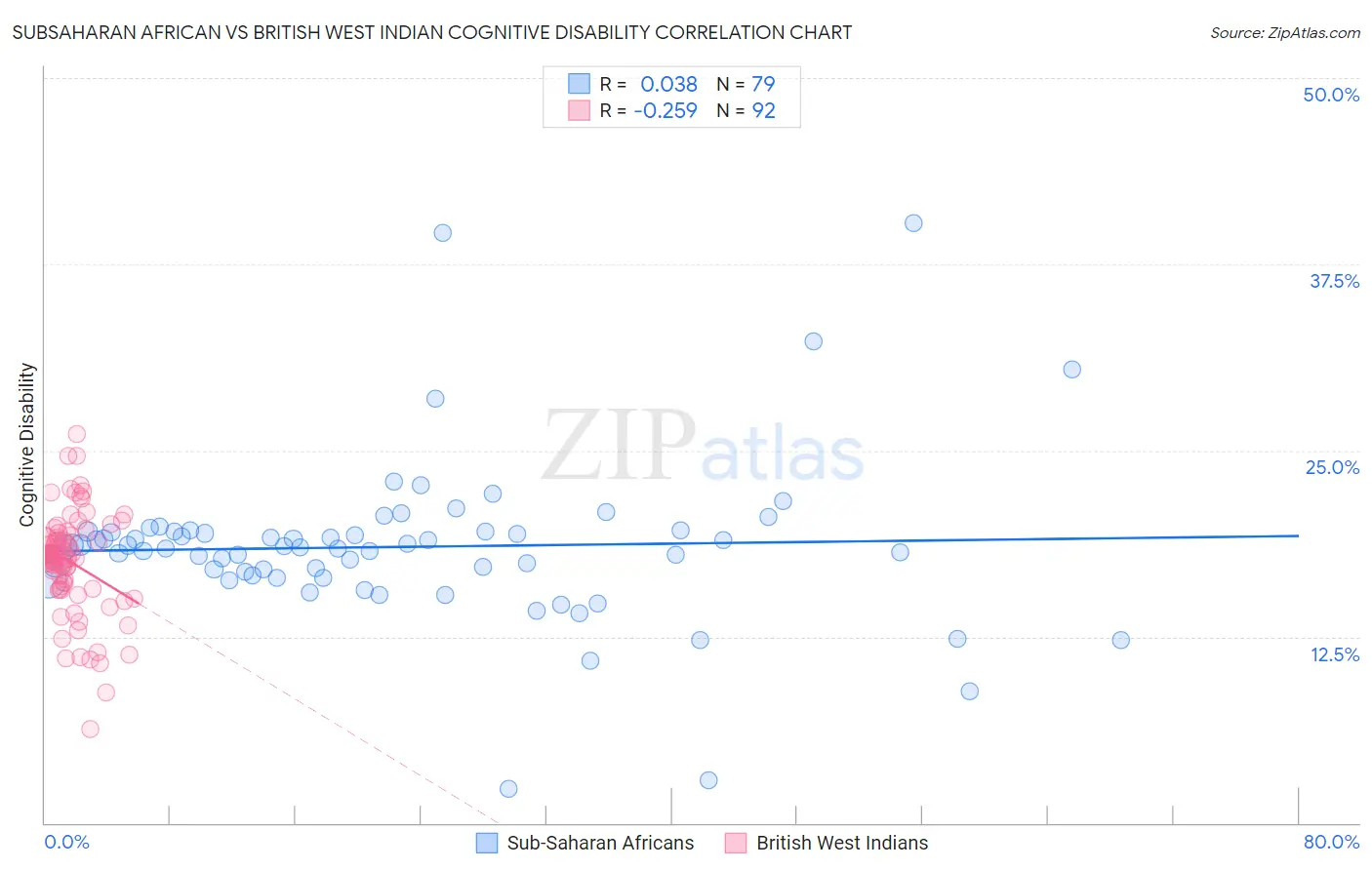Subsaharan African vs British West Indian Cognitive Disability
COMPARE
Subsaharan African
British West Indian
Cognitive Disability
Cognitive Disability Comparison
Sub-Saharan Africans
British West Indians
18.5%
COGNITIVE DISABILITY
0.0/ 100
METRIC RATING
314th/ 347
METRIC RANK
18.2%
COGNITIVE DISABILITY
0.1/ 100
METRIC RATING
294th/ 347
METRIC RANK
Subsaharan African vs British West Indian Cognitive Disability Correlation Chart
The statistical analysis conducted on geographies consisting of 508,099,215 people shows no correlation between the proportion of Sub-Saharan Africans and percentage of population with cognitive disability in the United States with a correlation coefficient (R) of 0.038 and weighted average of 18.5%. Similarly, the statistical analysis conducted on geographies consisting of 152,692,524 people shows a weak negative correlation between the proportion of British West Indians and percentage of population with cognitive disability in the United States with a correlation coefficient (R) of -0.259 and weighted average of 18.2%, a difference of 1.8%.

Cognitive Disability Correlation Summary
| Measurement | Subsaharan African | British West Indian |
| Minimum | 2.3% | 6.3% |
| Maximum | 40.3% | 26.1% |
| Range | 38.0% | 19.8% |
| Mean | 18.5% | 17.5% |
| Median | 18.5% | 18.0% |
| Interquartile 25% (IQ1) | 16.6% | 16.0% |
| Interquartile 75% (IQ3) | 19.6% | 19.1% |
| Interquartile Range (IQR) | 2.9% | 3.2% |
| Standard Deviation (Sample) | 5.5% | 3.4% |
| Standard Deviation (Population) | 5.5% | 3.4% |
Demographics Similar to Sub-Saharan Africans and British West Indians by Cognitive Disability
In terms of cognitive disability, the demographic groups most similar to Sub-Saharan Africans are Yaqui (18.5%, a difference of 0.060%), Chickasaw (18.5%, a difference of 0.17%), Hmong (18.4%, a difference of 0.45%), Choctaw (18.4%, a difference of 0.48%), and Immigrants from Eastern Africa (18.4%, a difference of 0.85%). Similarly, the demographic groups most similar to British West Indians are German Russian (18.2%, a difference of 0.17%), Immigrants from Burma/Myanmar (18.2%, a difference of 0.20%), Blackfeet (18.3%, a difference of 0.34%), Japanese (18.3%, a difference of 0.34%), and Ghanaian (18.3%, a difference of 0.37%).
| Demographics | Rating | Rank | Cognitive Disability |
| British West Indians | 0.1 /100 | #294 | Tragic 18.2% |
| German Russians | 0.0 /100 | #295 | Tragic 18.2% |
| Immigrants | Burma/Myanmar | 0.0 /100 | #296 | Tragic 18.2% |
| Blackfeet | 0.0 /100 | #297 | Tragic 18.3% |
| Japanese | 0.0 /100 | #298 | Tragic 18.3% |
| Ghanaians | 0.0 /100 | #299 | Tragic 18.3% |
| Creek | 0.0 /100 | #300 | Tragic 18.3% |
| Immigrants | Ghana | 0.0 /100 | #301 | Tragic 18.3% |
| Barbadians | 0.0 /100 | #302 | Tragic 18.3% |
| Immigrants | Kenya | 0.0 /100 | #303 | Tragic 18.3% |
| Immigrants | Eritrea | 0.0 /100 | #304 | Tragic 18.3% |
| Colville | 0.0 /100 | #305 | Tragic 18.3% |
| Seminole | 0.0 /100 | #306 | Tragic 18.3% |
| Ugandans | 0.0 /100 | #307 | Tragic 18.3% |
| Immigrants | Western Africa | 0.0 /100 | #308 | Tragic 18.4% |
| Immigrants | Eastern Africa | 0.0 /100 | #309 | Tragic 18.4% |
| Choctaw | 0.0 /100 | #310 | Tragic 18.4% |
| Hmong | 0.0 /100 | #311 | Tragic 18.4% |
| Chickasaw | 0.0 /100 | #312 | Tragic 18.5% |
| Yaqui | 0.0 /100 | #313 | Tragic 18.5% |
| Sub-Saharan Africans | 0.0 /100 | #314 | Tragic 18.5% |